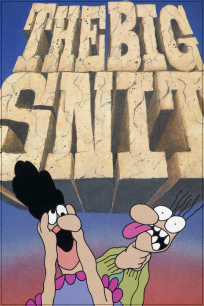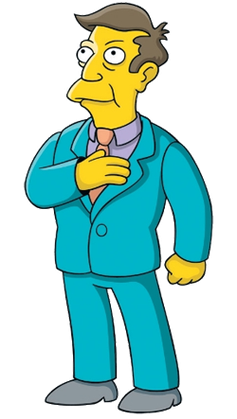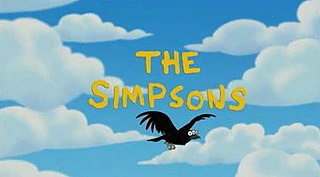
Homer Jay Simpson is the protagonist of the American animated sitcom The Simpsons. He is voiced by Dan Castellaneta and first appeared, along with the rest of the Simpsons, in The Tracey Ullman Show short "Good Night" on April 19, 1987. Homer was created by the cartoonist Matt Groening while he was waiting in the lobby of producer James L. Brooks's office. Groening had been called to pitch a series of shorts based on his comic strip Life in Hell but instead created a new set of characters. He named the character after his father, Homer Groening. After appearing for three seasons on The Tracey Ullman Show, the Simpsons received their own series on Fox, which debuted on December 17, 1989.

Bartholomew Jojo "Bart" Simpson is a fictional character in the American animated television series The Simpsons and part of the Simpson family. He is voiced by Nancy Cartwright and first appeared on television in The Tracey Ullman Show short "Good Night" on April 19, 1987. Cartoonist Matt Groening created and designed Bart while waiting in the lobby of James L. Brooks' office. Groening had been called to pitch a series of shorts based on his comic strip, Life in Hell, but instead decided to create a new set of characters. While the rest of the characters were named after Groening's family members, Bart's name is an anagram of the word brat. After appearing on The Tracey Ullman Show for two years, the Simpson family received its own series on Fox, which debuted December 17, 1989. Bart has appeared in every Simpsons episode except "Four Great Women and a Manicure".

"Simpsons Roasting on an Open Fire" is the series premiere of the American animated television series The Simpsons. It first aired on Fox in the United States on December 17, 1989. Introducing the Simpson family into half-hour television in this episode, Bart Simpson disobediently gets a tattoo without the permission of his parents. After Marge spends all the family's holiday budget on having it removed, Homer learns that his boss is not giving employees Christmas bonuses, and takes a job as a shopping mall Santa.
"Bart the General" is the fifth episode of the American animated television series The Simpsons. It originally aired on Fox in the United States on February 4, 1990. In the episode, Bart Simpson enlists Grampa's help to battle local bully Nelson Muntz. Bart unites the neighborhood children against Nelson and defeats him. The episode was directed by David Silverman and was the first to be written by John Swartzwelder.

The Itchy & Scratchy Show is a fictional animated series featured on The Simpsons. The cartoon depicts a blue mouse named Itchy, and a black cat named Scratchy, who repeatedly maim or kill each other. It is typically presented as 15- to 60-second shorts that are a part of The Krusty the Clown Show. Itchy & Scratchy is filled with graphic violence that almost invariably prompts laughter from The Simpsons characters, especially Bart and Lisa.
"Some Enchanted Evening" is the thirteenth and final episode of the first season of the American animated television series The Simpsons. It was originally broadcast on the Fox network in the United States on May 13, 1990. Written by Matt Groening and Sam Simon and directed by David Silverman and Kent Butterworth, "Some Enchanted Evening" was the first episode produced for season one and was intended to air as the series premiere in fall 1989, but aired as the season one finale due to animation problems. The Christmas special "Simpsons Roasting on an Open Fire" premiered in its place on December 17, 1989. It is the last episode to feature the original opening sequence starting from "Bart the Genius". In the episode, Homer and Marge go on a night out while leaving the children under the care of a diabolical babysitter named Ms. Lucille "Botz" Botzcowski.
"The Simpsons 138th Episode Spectacular" is the tenth episode of the seventh season of the American animated television series The Simpsons. It originally aired on the Fox network in the United States on December 3, 1995. As the title suggests, it is the 138th episode and the third clip show episode of The Simpsons, after "So It's Come to This: A Simpsons Clip Show" and "Another Simpsons Clip Show".

"Burns Verkaufen der Kraftwerk" is the eleventh episode of the third season of the American animated television series The Simpsons. It first aired on the Fox network in the United States on December 5, 1991. In the episode, Mr. Burns sells the power plant to two German investors for $100 million. The new owners immediately fire Homer, the plant's safety inspector, for his incompetence. Burns soon realizes his former workers no longer fear him and buys the plant back to regain their respect.
"Bart the Lover" is the 16th episode of the third season of the American animated television series The Simpsons. It first aired on the Fox network in the United States on February 13, 1992. In the episode, Bart, playing a prank on his teacher Edna Krabappel, responds to her personal ad as a man named Woodrow. In the subplot, Ned Flanders asks Homer to curtail his swearing, so Homer starts using a swear jar.
"So It's Come to This: A Simpsons Clip Show" is the eighteenth episode of the fourth season of the American animated television series The Simpsons. It originally aired on the Fox network in the United States on April Fools' Day, 1993. In the episode, Homer plays a series of practical jokes on Bart, and to get even, Bart shakes up a can of Homer's beer with a paint shaker. Homer opens the can, resulting in a huge explosion that lands him in the hospital, where he goes into a coma. At Homer's bedside, the Simpson family reminisce, mainly about moments relevant to Homer's life.
"The Front" is the nineteenth episode of the fourth season of the American animated television series The Simpsons. It originally aired in the United States on the Fox network on April 15, 1993. In the episode, Bart and Lisa decide to write an episode of The Itchy & Scratchy Show; after their script is rejected, they resubmit it under the name of their grandfather Abraham Simpson, resulting in Grampa being hired as a staff writer. Meanwhile, Homer returns to high school to retake a failed science course.

The Big Snit is a 1985 animated short film written and directed by Richard Condie and produced by the National Film Board of Canada.
"Black Widower" is the twenty-first episode of the third season of the American animated television series The Simpsons. It originally aired on the Fox network in the United States on April 9, 1992. The episode was written by Jon Vitti and directed by David Silverman. Kelsey Grammer guest starred as Sideshow Bob for the second time. In the episode, Sideshow Bob — Bart's new archenemy — returns, apparently in a romantic relationship with Bart's aunt Selma, but when Bart later realizes that Bob is planning to kill Selma, he prevents the attempted murder and Bob is sent back to prison. "Black Widower" finished 39th in Nielsen ratings for the week that it originally aired. Reviewers generally enjoyed the episode, and gave Grammer's portrayal of Sideshow Bob particular praise.

Principal Seymour Skinner is a recurring fictional character in the animated sitcom The Simpsons, who is voiced by Harry Shearer. He is the principal of Springfield Elementary School, which he struggles to control, and is constantly engaged in a battle against its inadequate resources, apathetic and bitter teachers, and often rowdy and unenthusiastic students, Bart Simpson being a standout example.
"Another Simpsons Clip Show" is the third episode of the sixth season of the American animated television series The Simpsons. It originally aired on the Fox network in the United States on September 25, 1994. In the episode, Marge reads a romance novel in bed, and it prompts her to have a family meeting, where the Simpson family recall their past loves in form of clips from previous episodes.

The fifth season of the American animated television series The Simpsons originally aired on the Fox network between September 30, 1993, and May 19, 1994. The showrunner for the fifth production season was David Mirkin who executive produced 20 episodes. Al Jean and Mike Reiss executive produced the remaining two, which were both hold overs that were produced for the previous season. The season contains some of the series' most acclaimed and popular episodes, including "Cape Feare", "Lisa vs. Malibu Stacy", "Homer Goes to College", "Deep Space Homer", and "Rosebud". It also includes the 100th episode, "Sweet Seymour Skinner's Baadasssss Song". The season was nominated for two Primetime Emmy Awards and won an Annie Award for Best Animated Television Program as well as an Environmental Media Award and a Genesis Award. The DVD box set was released in Region 1 on December 21, 2004, Region 2 on March 21, 2005, and Region 4 on March 23, 2005.

The Simpsonsopening sequence is the title sequence of the American animated television series The Simpsons. It is accompanied by "The Simpsons Theme". The first episode to use this introduction was the series' second episode "Bart the Genius".

The Simpsons is an American animated television sitcom starring the animated Simpson family, which was created by Matt Groening. He conceived of the characters in the lobby of James L. Brooks's office and named them after his own family members, substituting "Bart" for his own name. The family debuted as shorts on The Tracey Ullman Show on April 19, 1987. After a three-season run, the sketch was developed into a half-hour prime time show called The Simpsons, which debuted on December 17, 1989. The show was an early hit for Fox, becoming the first Fox series to land in the top 30 ratings in a season (1990).

The Simpsons is an American animated comedy franchise whose eponymous family consists of Homer, Marge, Bart, Lisa, and Maggie. The Simpsons were created by cartoonist Matt Groening for a series of animated shorts that debuted on The Tracey Ullman Show on Fox on April 19, 1987. After a three-season run, the sketch was developed into The Simpsons, a half-hour prime time show that was an early hit for Fox, becoming the first Fox series to land in the Top 30 ratings in a season (1989–1990). The popularity of The Simpsons has made it a billion-dollar merchandising and media franchise. Alongside the television series, the characters of the show have been featured in a variety of media, including books, comic books, a magazine, musical releases, and video games.













